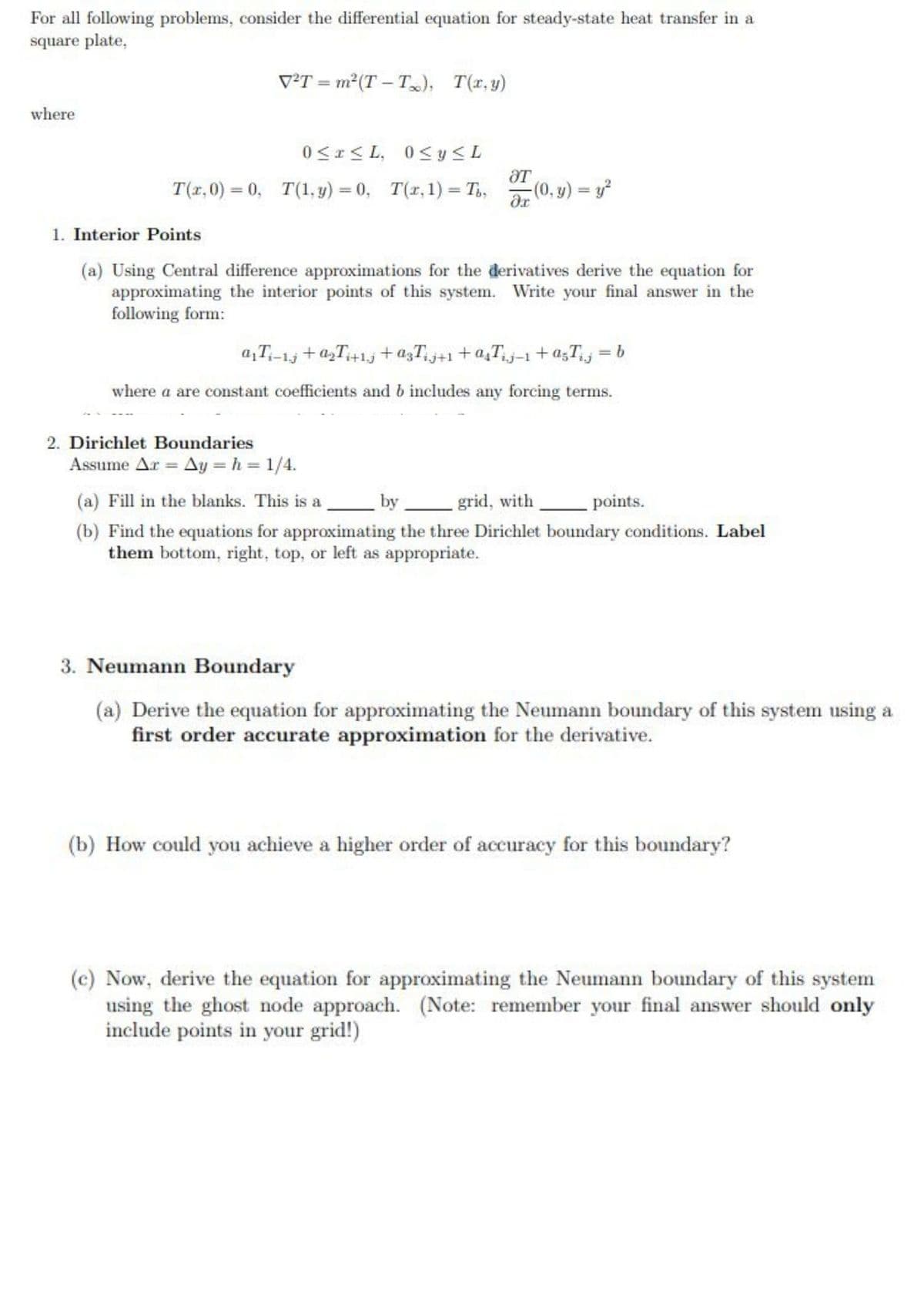3. Neumann Boundary (a) Derive the equation for approximating the Neumann boundary of this system using a first order accurate approximation for the derivative. (b) How could you achieve a higher order of accuracy for this boundary? (c) Now, derive the equation for approximating the Neumann boundary of this system using the ghost node approach. (Note: remember your final answer should only include points in your grid!)
3. Neumann Boundary (a) Derive the equation for approximating the Neumann boundary of this system using a first order accurate approximation for the derivative. (b) How could you achieve a higher order of accuracy for this boundary? (c) Now, derive the equation for approximating the Neumann boundary of this system using the ghost node approach. (Note: remember your final answer should only include points in your grid!)
Advanced Engineering Mathematics
10th Edition
ISBN:9780470458365
Author:Erwin Kreyszig
Publisher:Erwin Kreyszig
Chapter2: Second-order Linear Odes
Section: Chapter Questions
Problem 1RQ
Related questions
Question
Q3

Transcribed Image Text:For all following problems, consider the differential equation for steady-state heat transfer in a
square plate,
V²T = m²(T – T); T(x,y)
where
0<r< L, 0<y<L
T(x,0) = 0, T(1, y) = 0, T(r, 1) = T,,
(0, y) y?
%3D
1. Interior Points
(a) Using Central difference approximations for the derivatives derive the equation for
approximating the interior points of this system. Write your final answer in the
following form:
a,T;-1j + a,T+1j +a3Tj+1+a,Tj-1 +a;T = b
where a are constant coefficients and b includes any forcing terms.
2. Dirichlet Boundaries
Assume Ar Ay = h = 1/4.
(a) Fill in the blanks. This is a
by grid, with
points.
(b) Find the equations for approximating the three Dirichlet boundary conditions. Label
them bottom, right, top, or left as appropriate.
3. Neumann Boundary
(a) Derive the equation for approximating the Neumann boundary of this system using a
first order accurate approximation for the derivative.
(b) How could you achieve a higher order of accuracy for this boundary?
(c) Now, derive the equation for approximating the Neumann boundary of this system
using the ghost node approach. (Note: remember your final answer should only
include points in your grid!)
Expert Solution
This question has been solved!
Explore an expertly crafted, step-by-step solution for a thorough understanding of key concepts.
Step by step
Solved in 5 steps with 5 images

Recommended textbooks for you

Advanced Engineering Mathematics
Advanced Math
ISBN:
9780470458365
Author:
Erwin Kreyszig
Publisher:
Wiley, John & Sons, Incorporated

Numerical Methods for Engineers
Advanced Math
ISBN:
9780073397924
Author:
Steven C. Chapra Dr., Raymond P. Canale
Publisher:
McGraw-Hill Education

Introductory Mathematics for Engineering Applicat…
Advanced Math
ISBN:
9781118141809
Author:
Nathan Klingbeil
Publisher:
WILEY

Advanced Engineering Mathematics
Advanced Math
ISBN:
9780470458365
Author:
Erwin Kreyszig
Publisher:
Wiley, John & Sons, Incorporated

Numerical Methods for Engineers
Advanced Math
ISBN:
9780073397924
Author:
Steven C. Chapra Dr., Raymond P. Canale
Publisher:
McGraw-Hill Education

Introductory Mathematics for Engineering Applicat…
Advanced Math
ISBN:
9781118141809
Author:
Nathan Klingbeil
Publisher:
WILEY

Mathematics For Machine Technology
Advanced Math
ISBN:
9781337798310
Author:
Peterson, John.
Publisher:
Cengage Learning,

